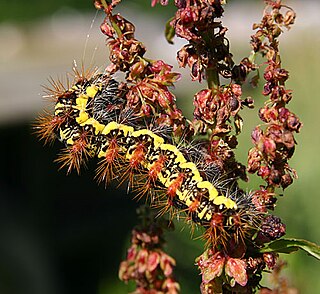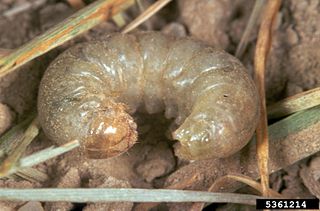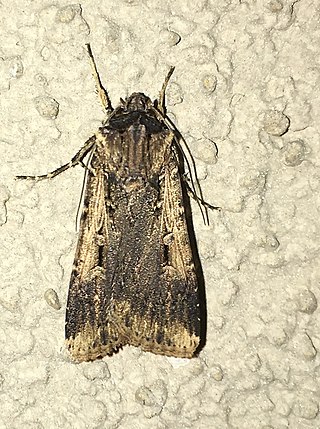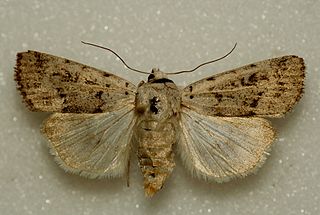
Agrotis segetum, sometimes known as the turnip moth, is a moth of the family Noctuidae. The species was first described by Michael Denis and Ignaz Schiffermüller in 1775. It is a common European species and it is found in Africa and across Eurasia except for the northernmost parts.

Schinia, commonly called flower moths, is a large genus of moths belonging to the family Noctuidae. The genus has a Holarctic distribution with the vast majority of species being found in North America, many with a very restricted range and larval food plant.

Agrotis is a genus of moths of the family Noctuidae. The genus was erected by Ferdinand Ochsenheimer in 1816. A number of the species of this genus are extinct.

Acronicta oblinita, the smeared dagger moth or arioch dagger, is a moth of the family Noctuidae. Its larva, the smartweed caterpillar, has urticating hairs. The species was first described by James Edward Smith in 1797.

Agrotis orthogonia, the pale western cutworm, is a moth of the family Noctuidae. The species was first described by Herbert Knowles Morrison in 1876. It is found in North America, more specifically dry, semi-desert areas of western North America from southern Canada to California, ranging eastward nearly to the eastern edge of the Great Plains.

Amolita is a genus of moths in the family Erebidae.

Euxoa tronellus is a moth of the family Noctuidae first described by Smith in 1903. It is found in western North America.

Agrotis vetusta, the old man dart, spotted-legged cutworm or muted dart is a moth of the family Noctuidae. The species was first described by Francis Walker in 1865. It is found in North America, from southern Alaska to Nova Scotia, southward into Mexico.

Agrotis robustior is a moth of the family Noctuidae first described by Smith in 1899. It is found on the northern Great Plains of North America, the Prairie Provinces of Canada southward to South Dakota and Colorado.

Agrotis venerabilis, the dusky cutworm, is a moth of the family Noctuidae. The species was first described by Francis Walker in 1857. It is found from coast to coast from central Canada south to Mexico.

Agrotis ruta is a moth of the family Noctuidae first described by Eduard Friedrich Eversmann in 1851. It has a Holarctic distribution. In North America it has a northern distribution, occurring from Alaska and the Yukon Territory to Labrador, south to northern Manitoba and British Columbia, and in the Rocky Mountains to southern Alberta. Furthermore, it can be found in the northern Urals, Siberia, Mongolia, China and Japan.

Agrotis stigmosa is a moth of the family Noctuidae first described by Herbert Knowles Morrison in 1875. It is found in North America from New England and Quebec west to Colorado and eastern Alberta. It is listed as a species of special concern in the US state of Connecticut.

Agrotis vancouverensis, the Vancouver dart, is a moth of the family Noctuidae. The species was first described by Augustus Radcliffe Grote in 1873. It is found in the Pacific Northwest of North America and is common west of the Cascade Mountains.

Agrotis volubilis, the voluble dart moth, is a moth of the family Noctuidae. The species was first described by Leon F. Harvey in 1874. It is found in North America, from Newfoundland to British Columbia in Canada and in the United States from Maine to Florida and west to the West Coast.

Anicla tepperi is a moth of the family Noctuidae first described by Smith in 1888. It is found in North America from eastern Manitoba west to the Alberta foothills, north to about Lloydminster and south to southern Colorado.
Rhizagrotis stylata is a moth of the family Noctuidae first described by John Bernhardt Smith in 1893. It is found in North America from south-eastern Alberta south to at least Arizona.
Euxoa aurulenta, the dune cutworm, is a moth of the family Noctuidae. The species was first described by Smith in 1888. It is found in North America from Ontario west to Alberta and Washington, south to Illinois, Nebraska, Colorado and Arizona.
Diarsia calgary, the Calgary dart, is a moth of the family Noctuidae. The species was first described by Smith in 1898. It is found in North America in the mountains and foothills from Yukon, south to Arizona and New Mexico, west to the coast of British Columbia. There is a disjunct population in central western California.
Phalaenostola hanhami, also called Hanham's owlet or Hanham's snout moth, is a litter moth of the family Erebidae. The species was first described by J. B. Smith in 1899. It is found in North America from Nova Scotia, west across Canada to central Alberta, south to Massachusetts and New York.

Amolita obliqua, the oblique grass moth, is an owlet moth in the family Erebidae. The species was first described by Smith in 1903. It is found in North America.
















